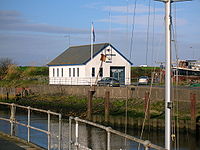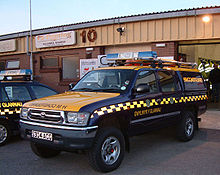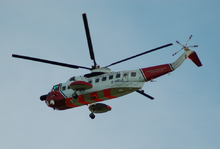- Her Majesty's Coastguard
-
Her Majesty's Coast Guard
Ensign of HM CoastguardActive 1829-present Country United Kingdom Type Coast guard Size 2 emergency towing vessels, 7 SAR helicopters, various rigid-hulled inflatable boats Part of Maritime and Coastguard Agency Motto Safer Lives, Safer Ships, Cleaner Seas (MCA) Commanders Chief Executive, MCA Sir Alan Massey Chief Coastguard, HMCG Rod Johnson Secretary of State for Transport The Rt Hon. Philip Hammond, MP Under-Secretary of State for Transport (Shipping) Mike Penning, MP Insignia Ensign Coat of Arms 
Aircraft flown Helicopter Sikorsky S-92, AgustaWestland AW139, Interceptor Britten-Norman Islander Patrol Cessna 404, Reims-Cessna F406 Her Majesty's Coastguard is the service of the government of the United Kingdom concerned with co-ordinating air-sea rescue.
HM Coastguard is a section of the Maritime and Coastguard Agency responsible for the initiation and co-ordination of all civilian maritime Search and Rescue (SAR) within the UK Maritime Search and Rescue Region. This includes the mobilisation, organisation and tasking of adequate resources to respond to persons either in distress at sea, or to persons at risk of injury or death on the cliffs or shoreline of the United Kingdom. The chief executive of the Maritime and Coastguard Agency is Sir Alan Massey. Operational control of the service is the responsibility of the Chief Coastguard.
Contents
History
In 1809 the Preventative Water Guard was established and can be regarded as the immediate ancestor of HM Coastguard. Its primary objective was to prevent smuggling, but it was also responsible for giving assistance to shipwrecks.
Each Water Guard station was issued with Manby's Mortar which was invented by Captain George William Manby. The mortar fired a shot with a line attached from the shore to the wrecked ship and was used for many years.
In 1821 a committee of enquiry recommended that responsibility for the Preventative Water Guard be transferred to the Board of Customs. The Treasury agreed and in a Minute dated 15 January 1822, directed that the preventative services, which consisted of the Preventative Water Guard, cruisers, and Riding Officers should be placed under the authority of the Board of Customs and in future should be named the Coast Guard.
In 1829 the first Coast Guard instructions were published and dealt with discipline and directions for carrying out preventative duties. They also stipulated that when a wreck took place, the Coast Guard was responsible for taking all possible action to save lives, to take charge of the vessel and to protect property.[1]
Efficiency drives in the 1990s made Her Majesty's Coastguard a government executive agency, then in 1998 the Marine Safety Agency and the Coastguard Agency were joined to become the Maritime and Coastguard Agency (MCA).
The Coastguard has a museum at Sewerby Hall near Bridlington to commemorate the 200 year history of the agency. HRH The Prince of Wales is an honorary Commodore of HM Coastguard.
Rank structure (Coastguard & Volunteer Coast Rescue)
Rank structure of Her Majesty's Coastguard Full-time
Coastguard ServiceRank Chief Coastguard Principal Officer Inspector District Officer Assistant
District OfficerWatch Officer Watch Assistant Insignia 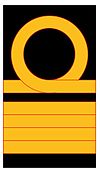
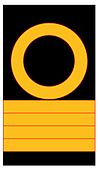
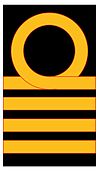
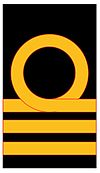
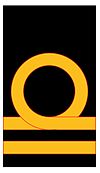
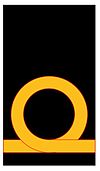
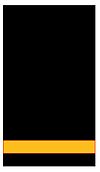
Volunteer
Coastguard ServiceRank Assistant
District OfficerStation Officer Deputy
Station OfficerRescue Officer Insignia 
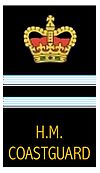

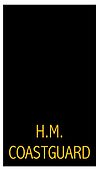
NB: Assistant District Officers are all full-time, but some work as Coastguard 'Watch Managers', whilst others supervise the volunteer coast rescue service as 'Sector Managers'.
Former rank structure
- Temporary Extraman (Tempo Y Exta)
- Permanent Extraman (Permanent Extraman)
- Boatman (Boatn)
- Commissioned Boatman (Comd Bn / Comd Btman)
- Chief Boatman (Chf btman / Chief Bn / Chief Boatn)
- Chief Officer (Chf Officer)
- Chief Coastguard
Role
The Maritime and Coastguard Agency (MCA) is an executive agency responsible throughout the UK for implementing the Government’s maritime safety policy. That includes co-ordinating search and rescue at sea through Her Majesty’s Coastguard, checking that ships meet UK and international safety rules and preventing coastal pollution.
Typical emergencies to which the Coastguard is summoned include:
- Sailboarders too exhausted to reach the shore;
- Walkers and animals who slip from cliff paths;
- Boats losing rudder control;
- Crew stranded aboard a container ship battered by freak waves;
- Medical emergencies;
- Incidents involving oil rigs (such as fire);
- Suicide victims that have jumped from cliffs or bridges;
- Missing adults and children around the cliffs or beach area;
- Broken Down Merchant Vessels in British waters;
- Evacuating injured persons at sea;
- Locating missing persons and vessels at sea;
- Fires on board Merchant vessels;
- Groundings;
- Collisions at sea;
Ships in distress or the public reporting an accident should make a Mayday call on MF radio, marine VHF radio channel 16, or by dialling 999 or 112 on a telephone. The Coastguard continuously monitors all the maritime distress frequencies (including the international VHF distress frequency 156.8 MHz) and has access to Satellite based monitoring systems. The Coastguard then co-ordinates the emergency response. This normally involves requesting the launch of a local RNLI lifeboat (the RNLI being an independent organization), launching an independent lifeboat, deploying a local Coastguard unit, or a search and rescue helicopter. On occasions, the Coastguard has called on warships of the Royal Navy to assist with incidents. Depending on the circumstances of each incident, the Coastguard may also arrange for other emergency services to be deployed to the incident or to meet other units returning from the incident, for example in the case of a medical emergency. A full list of 'Declared Assets' is below:
- HM Coastguard's own CRO (Coastguard Rescue Officers) Initial Response and Coastguard Rescue Teams;
- Inshore lifeboats, all-weather lifeboats and inshore rescue hovercraft operated by the Royal National Lifeboat Institution
- Other nominated inshore rescue services
- Search and rescue helicopters under contract to the MCA
- Ministry of Defence SAR helicopters and fixed wing aircraft operated by the Royal Air Force (RAF) and Royal Navy (RN)
- Emergency towing vessels (ETV) - powerful tugs contracted to the MCA
- Nominated Fire Service teams for cliff and mud rescue as well as firefighting and chemical incident response for vessels at sea
- Nominated beach lifeguard units
Declared Assets are Facilities that have given a declaration to the Coastguard of a certain level of availability or training. Other assets that may be tasked to assist with any incident include; Mountain Rescue, Military Police, The Fire and Rescue Service and Volunteer Lifeguards. In addition, various 'Memorandums of Understanding' exist between the Coastguard and other Emergency Services to establish priority when working in each others areas. For example, police officers needing to carry out a search of the shoreline.
The Coastguard has seven rescue helicopters based around the United Kingdom (at Stornoway Airport, Sumburgh Airport, Lee-on-Solent, Portland). The Coastguard also has use of other Air-Sea Rescue helicopters provided by the Royal Navy, Royal Air Force, United States Air Force and the Irish Coast Guard.
Operations
HM Coastguard operates out of bases or Maritime Rescue Co-ordination Centres which are divided into three group areas: [2]
Scotland and Northern Ireland Region
Wales and West of England Region
East of England Region
- Dover
- Humber (Bridlington)
- London
- Portland
- Solent
- RNAS Lee-on-Solent (HMS Daedalus) - Lee-on-Solent
- Thames
- Yarmouth
Until 2001 stations were also operated in Tynemouth, Oban and Pentland.
Communications
A variety of communication platforms are used depending on the individual asset and situation. Communication involving Coastguard Rescue Teams, inshore lifeboats (operated by the RNLI), other nominated inshore rescue teams and SAR air assets (both MOD and MCA) typically take place over VHF marine radio. Communication between normal vessels and HM Coastguard/Maritime Rescue Co-ordination Centre's can take place over VHF radio, MF radio and telephone (Satellite, Landline and Mobile).
Isle of Man
Since 1989, the Isle of Man has had its own Coastguard service. It was created in response to the closure of the HM Coastguard station at Ramsey. HM Coastguard in Liverpool retained responsibility for all sea-rescues off the Manx coast until 1991, when the Isle of Man Government purchased territorial waters from the United Kingdom.
Fleet Assets
The MCA operates various Pacific 32 rigid-hulled inflatable boats (RHIBs). From 1993 through 2011 the MCA chartered the United Kingdom's emergency towing vessel fleet from Klyne Tugs of Lowestoft, the Anglian Prince, Anglian Sovereign, Anglian Monarch and Anglian Princess. The MCA also charters the UK's Emergency tow vessel fleet, set up in 1993, but to be disbanded in September 2011.[3][4][5]
Air Assets
Fixed wing (operated by Atlantic Airlines under contract)[6]
- 2 Lockheed L-188 Electra - pollution spraying
- 1 Britten-Norman BN-2 Islander - surveillance
- 1 Cessna 404 - pollution patrol/spraying
- 1 Reims-Cessna F406 - pollution patrol
Helicopters (operated by CHC Helicopter under contract)[6]
- 4 Sikorsky S-92 - search and rescue
- 3 AgustaWestland AW139 - search and rescue
See also
References
- ^ [1] National Archives - Coastguard History (1992 Memorandum)
- ^ [2] Maritime and Coastguard Agency - Area of Operations
- ^ "Spending review: Emergency tug service to be withdrawn". BBC News. 20 October 2010. Archived from the original on 22 October 2010. http://www.webcitation.org/5tffCDucg. Retrieved 22 October 2010.
- ^ "Emergency tugs to be scrapped". STV. 21 October 2010. Archived from the original on 22 October 2010. http://www.webcitation.org/5tffCQOLN. Retrieved 22 October 2010.
- ^ "Anglian Prince is sold". Maritime Journal. 2011-07-21. http://www.maritimejournal.com/features101/tugs,-towing,-pollution-and-salvage/tugs,-towing-and-salvage/anglian-prince-is-sold. Retrieved 2011-11-08.
- ^ a b "United Kingdom Coast Guard Aviation". Aeroflight. http://www.aeroflight.co.uk/waf/uk/cg/ukaf-cg-home.htm.
External links
- Her Majesty's Coastguard site
- History of HM Coastguard
- National Archives, Coastguard: Military Records Information 44 leaflet
- National Archives Wiki - Coastguard History
Coast guards Argentina · Aruba · Australia · Bangladesh · Barbados · Belize · Canada · China · Croatia · Cyprus · Egypt · France · Germany · Greece · Haiti · Iceland · India · Ireland · Italy · Japan · South Korea · Malaysia · Maldives · New Zealand · Netherlands · Netherlands (Caribbean) · Norway · Pakistan · Peru · Philippines · Russia · Singapore · Sri Lanka · Sweden · Taiwan · Turkey · Ukraine · United Arab Emirates · United Kingdom · United States of America · VietnamCategories:- Organizations established in 1829
- Coast guards
- Sea rescue organisations of the United Kingdom
- Department for Transport
- 1829 establishments in the United Kingdom
Wikimedia Foundation. 2010.


